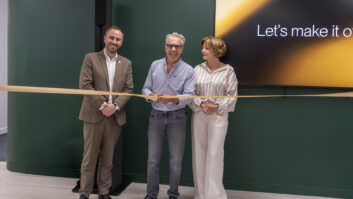TWICE: What challenges face custom installers during the next few years?
Harary: The basis of many of the questions you sent to us in advance was the definition of the direction, and the reason, for the existence of custom installers. In any business, it is all about determining the consumer’s expectations and perceptions of added value. If custom installers and manufacturers can’t define what represents true added value, then none of us can really charge anything for our products or services.
If you look at mass merchant retailers, their delivery people bring you a 32-inch TV and drop it off at your door. If they help you get it out of the box, it is a good thing. But United Audio’s delivery people don’t leave until the products are set up and working. So the bar continues to get raised. That’s the key for all of us: being able to define and understand the added value that we can charge for.
Weisenberg: One of the challenges that has been magnified with the acceleration of technology is finding and keeping qualified installation people who want to run wire, who are knowledgeable, and who are skilled in every aspect of the installation process.
It is one of the industry’s limiting factors. Custom installers are running out of time to do installations because they don’t have enough people to do them.
Sterns: I agree. The labor issue also affects manufacturers. We have all these wonderful value-added ideas that are put on the back burner for a lack of trained resources.
We have ideas and concepts for advanced systems that could add value to the user, but we cannot find engineers and product managers to specify the details of those products. We cannot find retailers capable of learning them and we don’t have enough trainers to teach them.
Ekblad: One of the biggest challenges facing custom installers is understanding the products that are going to be integrated into a system and making sure the products live up to the expectations that we have presented for our customer.
Bodley: If you look at what many industries do to attract high-school graduates, an amazing amount of recruiting is going on, but our industry hasn’t put forth that awareness. A lot of people who graduate from high school don’t have a clue that there is a career in installing home systems, but when they find out about it, they are much more excited about it than they are about computer programming or repair.
The other challenge is that top management in many [retail] companies has not made the decision to really be in the business. When a retailer I was with got into the business, we set aside display space, put in installation bays, invested in tools, trained the people. But all too often, because of the blur between an audio/video retail sale and an audio/ video custom-install sale – because it consists of the same products and you use a lot of the same existing infrastructure – being in the business does not become part of the company’s culture.
As for installer shortage, I gave up trying to find people who are already trained. We are all just fishing in the same fished-out lake, and the big fish are jumping from boat to boat to get higher wages. We have decided to grow our own. My company made a commitment to find people with the correct brain cells, and we are going to train them from the ground up. That’s the way car stereo dealers found installers.
Sterns: I am on the Board of Directors of CEMA’s Integrated Home Systems Division, which has joined with CEDIA and other associations in related industries to develop a junior college curriculum for installers and integrated home-systems specifiers. There is impetus to develop a formalized career path, but it is probably a few years away still.
Harary: We have an industry-wide problem convincing the outside world that there is a reason to join our industry rather than get into the computer industry.
On the retail side, some of our biggest customers face similar issues in getting qualified salespeople who are going to interact with consumers on a day-to-day basis and be reasonably educated.
It seems like we need to spend time creating romance about the business so that more people will see this as a career-path choice and enter the talent pool. In the ’70s, hifi was the hot thing to do. Computers have been the hot thing to do since the ’80s. We need to make our industry the hot thing [again].
Goldstein: Many installation companies turn away business because they don’t have enough hands to complete the jobs they’ve lined up, and I have seen our volume double with particular accounts after they expanded their sales and installation teams.
Another issue facing the industry is installers’ business acumen. Among guys running non-retail-based custom installation businesses, many of them have been in it for years and are reaching a maturity point at which we can interact with them like any other business. But an awful lot of capable, qualified installers don’t have a clue about doing business with somebody.
That’s a challenge the industry must confront: helping the small independent contractor and the small installation company figure out how to do business. That’s a key reason holding back these companies’ growth. So we are trying to be a business consultant to help them.
Ekblad: We had to create a career path within our company. It starts with our delivery/set-up service people. In some of them, we have been able to recognize the ability to go beyond. We try to bring them up to another level of delivery in which they do in-wall wiring or other jobs that can be completed in about 13 man hours, or 6.5 hours for a team of two. From there, we can nurture them to the next level: custom installs.
To do that, we have had to do a couple of things. One is recruit these people into our business, and the best way seems to be with referrals, so we have set up an incentive program for referrals.
Second, we expanded our training quite a bit. We can’t depend on just vendor training. It’s an excellent resource. But we have developed our own training and spent a considerable amount of effort developing a team of trainers that can bring our people along.
Sheldon: United Audio has an advantage in this situation because it is a well-run business moving into custom and has a structure in place that lets them enjoy a certain level of immediate success.
The lack of business acumen by a lot of small installers parallels what we saw in specialty retail in the ’70s and ’80s, when hobbyists opened a business because of their passion for audio. At that time, there really wasn’t a solid resource for small retail companies to learn the requisite business skills. But it’s quite different today because CEDIA is structured around education, and people with talent and ability within CEDIA are willing to share their expertise. That will let the custom industry accomplish things that the hifi industry couldn’t in the ’70s and ’80s.
Harary: Some people within the industry believe we can’t find enough talent to deal with demand. But many also say there’s no demand because we haven’t educated people. Is it both?
Ekblad: As a retailer trying to develop customers for this service, it boils down to having an educated sales team capable of stimulating a customer to go beyond a single-box purchase. That requires not only educating that customer but also merchandising in a way that takes advantage of your existing traffic.
You have to make it easy for them to understand. We have a 10-foot, 10-second rule: having an add-on sale display that’s no more than about 10 feet away and makes the add-on very desirable in about 10 seconds.
Harary: But do you have the talent to satisfy the demand you are creating?
Ekblad: Within our organization, yes.
Harary: But when I look at United Audio’s business and Keith Rich’s business, they are pretty different. Keith’s a full integrator of everything. The only thing Keith doesn’t integrate is brushing your teeth. And United is doing more traditional custom installation of audio-video. Is there a talent pool difference between the two aspects of the business?
Rich: In my business, everyone in the company has to understand everything about this industry. My assemblers know the whole gamut. They could almost be project managers [on a home-building project]. It is much more difficult to find talent that understands the whole gamut.
Harary: Is your business currently being limited by that?
Rich: No. I hire them. I will find them. I am not really ever concerned that I can’t get a job done. It’s the awareness. It’s the salespeople. The hardest employee I have to find is a good sales engineer, somebody who can talk the construction lingo, understand all the disciplines and direct consultants.
Ekblad: Our business is not being limited by [a tight supply of installers]. I think it’s a matter of us having very controlled and careful growth.
Harary: If anybody out there is saying there’s a huge demand but we can’t find the talent to support it, I guarantee you that Circuit City or someone will find some way to satisfy demand.
Sterns: I spent time with an owner of one of the premiere installation companies, which has 50 installers out there, and he was debating whether to take on any more new customers because the old customers weren’t getting serviced. They used to send two installers out to a job. Now they are sending one.
Bodley: Here’s an aspect of the business that many custom installers don’t get. We have a long-term relationship with our customers. If you do an installation, and your tree grows crooked right out of the ground, you are going to pay the price years later.
The other thing is that [the labor shortage] isn’t a demand issue. It’s an opportunity issue. There is an opportunity to close a lot of business, and the temptation is to do so. It’s a vicious circle. Cash flow will get you through times of no profit much better than profit will get you through times of no cash flow.
There are businessmen who start their business on customer deposits and all of a sudden, they need cash, so they take on another job without thinking about whether they have time to do it.
TWICE: More retailers are diversifying into custom. Is this further diluting the talent pool, and is the labor shortage preventing more retailers from diversifying into custom?
Bodley: Radio Shack announced it would offer installation. [In January, Radio Shack announced plans to create a nationwide team of installers and delivery vans to install bandwidth connections such as cable modems and T-1 lines.] I saw it as one of the greatest pieces of news ever because outfitting 7,000 stores with people to install basic systems will expand the talent pool.
Radio Shack has the ability to drive that business. Now, it depends on how scared you are of the concept. I don’t think they are ever going to compete with me, and certainly not with Keith.
Radio Shack’s entry creates an opportunity for more people to see what’s going on, and I think the fear of dilution and competition would be myopic.
Goldstein: Generating new talent is a challenge for an industry that has grown so quickly, and CEDIA and other organizations are starting to address that issue. CEDIA has an education initiative, as do CEMA and several other organizations. I think the talent challenge is temporary and can be overcome.
I think the industry’s growth opportunities are looking very good, and I think good businesspeople and good installers will be able to find and train good people. And as they grow the business and allow those good people to share in the success, they will continue to hold onto good people.
Harary: [The Radio Shack announcement] could, in fact, be a real boon for the industry as long as we understand what represents added value and that companies such as Keith’s represent the ultimate in added value.
As long as everybody understands the opportunity and continues to identify what added value means and knows how to charge for their added value, it will be fabulous. But if not, if Radio Shack begins to do what a United Audio can do or approaches what United can do, that is going to represent a problem.
Another thing: I think Microsoft has some ideas about this whole concept, and I believe that IEEE-1394 might lead house-builders to start putting that stuff through walls wherever they want. Then Keith will have to step up his added value.












